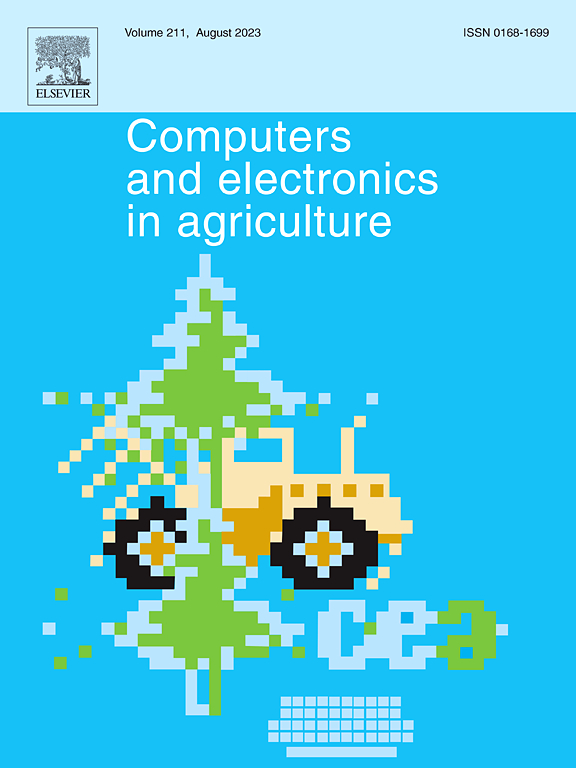基于SAR指数和变压器的高可转移稻田识别模型
IF 7.7
1区 农林科学
Q1 AGRICULTURE, MULTIDISCIPLINARY
引用次数: 0
摘要
人工智能模型是从遥感数据中准确识别水田的有力工具,对有效的农业管理和决策至关重要。由于历史和资金的限制,我们通常只有非常有限的样本,样本的特征不能完全覆盖所有地区和时间段。这就要求相应的模型具有良好的可转移能力。然而,建立一个可转移的模型也需要大量的样本。这一矛盾严重限制了我们在大时空范围内进行稻田识别的能力。为了解决这些问题,我们提出了一种基于Sentinel-1时间序列数据(Transferability-Index)的基于可转移指标转换器的稻田识别深度模型。可转移性指数构建了一种新的结构,将现有的SAR水田识别指标整合到神经网络中。这允许模型从构建之初就继承索引中包含的“识别经验”。这种结构与变压器结构相结合,可以仅使用少量样本构建高度可转移的模型。在本研究中,实验是在2018年到2021年的大范围内进行的,训练数据仅使用2021年的样本。与7种传统方法相比,对于2021年的测试数据,Transferability-Index的总体准确率为92.50%,高于其他方法。2018-2020年试验数据,可转移性指数分别达到87.75%、88.75%和89.38%,明显领先于对比方法。可转移性指数总体精度高,性能稳定,表明其在水田鉴定中具有较强的可转移性。可转移性指数模型可以作为水田测绘应用的有力工具,特别是在训练数据稀缺的情况下。本文章由计算机程序翻译,如有差异,请以英文原文为准。
Highly transferable paddy field identification model based on SAR index and transformer
Artificial intelligence models are powerful tools for accurately identifying paddy fields from remote sensing data, which is crucial for effective agricultural management and decision-making. Due to historical and funding constraints, we often have very limited samples available, and samples’ features cannot fully cover all regions and time periods. This requires the corresponding model to have good transferable capabilities. However, building a transferable model also requires a large number of samples. This contradiction severely limits our ability to perform paddy field identification over large spatial and temporal ranges. To address these challenges, we propose a transferable index transformer based deep model for paddy field identification based on Sentinel-1 time series data (Transferability-Index). Transferability-Index constructs a novel structure that integrates existing SAR paddy field identification indexes into the neural network. This allows the model to inherit the “identification experience” contained in the index from the very beginning of its construction. This structure, combined with the transformer structure, can build a highly transferable model using only a small number of samples. In this study, experiments were conducted over a large area from 2018 to 2021, the training data only used samples from 2021. In comparison with seven traditional methods, for the 2021 test data, Transferability-Index achieved an overall accuracy of 92.50%, which is higher than other methods. For the 2018–2020 test data, Transferability-Index achieved 87.75%, 88.75% and 89.38%, which is significantly ahead of the compared methods. The high overall accuracy and stable performance of Transferability-Index demonstrate its strong transferable capabilities in paddy field identification. The Transferability-Index model can serve as a potent tool for paddy field mapping applications, especially when training data are scarce.
求助全文
通过发布文献求助,成功后即可免费获取论文全文。
去求助
来源期刊

Computers and Electronics in Agriculture
工程技术-计算机:跨学科应用
CiteScore
15.30
自引率
14.50%
发文量
800
审稿时长
62 days
期刊介绍:
Computers and Electronics in Agriculture provides international coverage of advancements in computer hardware, software, electronic instrumentation, and control systems applied to agricultural challenges. Encompassing agronomy, horticulture, forestry, aquaculture, and animal farming, the journal publishes original papers, reviews, and applications notes. It explores the use of computers and electronics in plant or animal agricultural production, covering topics like agricultural soils, water, pests, controlled environments, and waste. The scope extends to on-farm post-harvest operations and relevant technologies, including artificial intelligence, sensors, machine vision, robotics, networking, and simulation modeling. Its companion journal, Smart Agricultural Technology, continues the focus on smart applications in production agriculture.
 求助内容:
求助内容: 应助结果提醒方式:
应助结果提醒方式:


